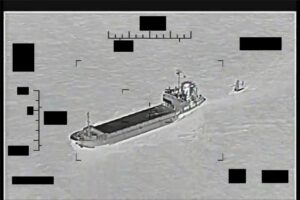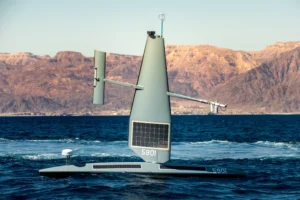A top Navy admiral said the service plans to keep unmanned surface vessels (USVs) with low to no intrinsic value or classified information kept aboard to protect against capture.
“The drones retain nothing of intrinsic value on them. This is part of one of the beauties of American technology. There is nothing classified or written on the platform. What is retained is minimal, and it’s all unclassified. So there’s no intrinsic value to get in these platforms,” Vice Adm. Brad Cooper, commander of 5th Fleet, told reporters during a media roundtable on Oct. 12.

The 5th Fleet has been testing USVs and artificial intelligence via Task Force 59 for over a year, with the aim to help integrate such systems into the Navy at large in the future (Defense Daily, Sept. 9, 2021).
Cooper noted the limited intrinsic value in USVs the Navy is experimenting with, like Saildrone vessels, helps limit the damage of attempts to capture them.
Notably, Iran attempted to capture several Saildrone USVs in late August and early September (Defense Daily, Aug. 30).
Cooper said Iran’s attempted seizure of the drones “were flagrant, they were deliberate. They were unwarranted that they were certainly not the actions of you expect of a professional maritime force and probably, more specifically, they were a direct violation of international law, so that that should be very clearly understood.”
He said they have seen this kind of “unsafe, unprofessional behavior” every couple of months.
However, he underscored the Navy is likely going to stick with the current model where the USVs do not retain any information they gather, but rather immediately relay it elsewhere, limiting the value from stealing them.
“As we look in the future, I’m somewhat reluctant to try to forecast all the things that American companies can produce. What I will say is I think we’re going to stick with our general model. There’ll be no drone that has intrinsic value while operating at sea. I think that serves us well,” Cooper said.
Cooper explained these dynamics as he outlined plans for the U.S. Navy seeks to create a network of 100 USVs between the U.S. and regional Middle East partners by the end of next summer (Defense Daily, Oct. 14).
He said the Navy puts measures in place with these USVs to store data on a cloud, “so really, these platforms simply serve as a service and as a passage of information, which we’re then able to take into our headquarters.”

Cooper also confirmed in the near term the Navy is working with essentially dual-use commercial technology for Task Force 59 experimentation, which will continue to limit the value of capturing Navy USVs in the region.
However he said this is “one element of a much broader Navy effort,” and the Pentagon will have to deal with the risks of classified hardware on other unmanned platforms.
“We’re very tightly plugged in with the Navy’s Unmanned Task Force that works out of here at the Pentagon. They have multiple – a large effort with other platforms” to address issues of classified parts on unmanned systems.
The Navy’s Unmanned Task Force was first announced in September 2021 to help quicken the pace at which unmanned systems are integrated into the Navy fleet (Defense Daily, Sept. 9, 2021).
In May, an official explained the unit had started a 12- to 18-month cross-functional pilot to help understand what specific problems unmanned systems or artificial intelligence could help solve for U.S. Fleet Forces Command and the U.S. Pacific Fleet via a venture capital model (Defense Daily, May 26).